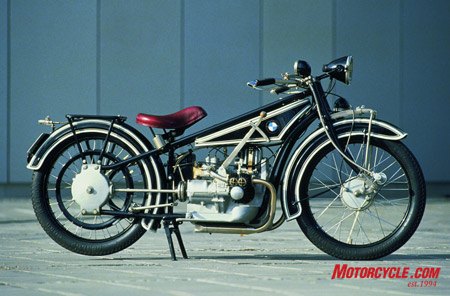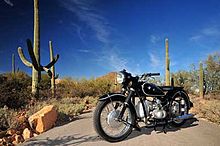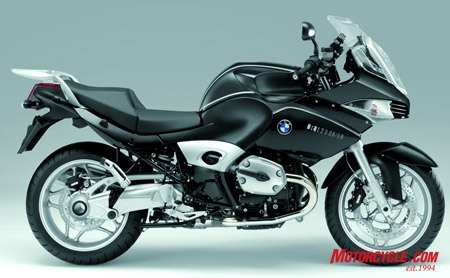See also: BMW Motorrad and History of BMW motorcycles


The R32 motorcycle, the first BMW motor vehicle.
BMW began building motorcycle engines and then motorcyclesafter World War I. Its motorcycle brand is now known as BMW Motorrad. Their first successful motorcycle, after the failed Helios and Flink, was the "R32" in 1923. This had a "boxer" twin engine, in which a cylinder projects into the air-flow from each side of the machine. Apart from their single cylinder models (basically to the same pattern), all their motorcycles used this distinctive layout until the early 1980s. Many BMWs are still produced in this layout, which is designated the R Series.




BMW K1200GT



BMW 1955 R67/3 was the last of the "plunger" models
During the Second World War, BMW produced the BMW R75 motorcycle with a sidecar attached. Featuring a unique design copied from the Zündapp KS750, its sidecar wheel was also motor-driven. Combined with a lockabledifferential, this made the vehicle very capable off-road, an equivalent in many ways to the Jeep.
In 1982, came the K Series, shaft drive but water-cooled and with either three or four cylinders mounted in a straight line from front to back. Shortly after, BMW also started making the chain-driven F and G series with single and parallel twin Rotax engines.
In the early 1990s, BMW updated the airhead Boxer engine which became known as the oilhead. In 2002, the oilhead engine had two spark plugs per cylinder. In 2004 it added a built-in balance shaft, an increased capacity to 1,170 cc and enhanced performance to 100 hp (75 kW) for the R1200GS, compared to 85 hp (63 kW) of the previous R1150GS. More powerful variants of the oilhead engines are available in the R1100S and R1200S, producing 98 hp (73 kW) and 122 hp (91 kW), respectively.
In 2004, BMW introduced the new K1200S Sports Bike which marked a departure for BMW. It features an engine producing 167 hp (125 kW), derived from the company's work with the Williams F1 team, and is lighter than previous K models. Innovations include electronically adjustable front and rear suspension, and a Hossack-type front fork that BMW calls Duolever.
BMW introduced anti-lock brakes on production motorcycles starting in the late 1980s. The generation of anti-lock brakes available on the 2006 and later BMW motorcycles pave the way for the introduction of electronic stability control, or anti-skid technology later in the 2007 model year.
BMW has been an innovator in motorcycle suspension design, taking up telescopic front suspension long before most other manufacturers. Then they switched to an Earles fork, front suspension by swinging fork (1955 to 1969). Most modern BMWs are truly rear swingarm, single sided at the back (compare with the regular swinging fork usually, and wrongly, called swinging arm). Some BMWs started using yet another trademark front suspension design, the Telelever, in the early 1990s. Like the Earles fork, the Telelever significantly reduces dive under braking.
In July 2007, the Italian-made Husqvarna Motorcycles was purchased by BMW for a reported €93 million. BMW Motorrad plans to continue operating Husqvarna Motorcycles as a separate enterprise. All development, sales and production activities, as well as the current workforce, have remained in place at its present location at Varese.[19] Husqvarna manufactures motocross, enduro andsupermoto motorcycles.
[edit]Automobiles
Main article: List of BMW vehicles
[edit]New Class
Main article: BMW New Class
The New Class (German: Neue Klasse) was a line of compact sedans and coupes starting with the 1962 1500 and continuing through the last 2002s in 1977. Powered by BMW's celebrated four-cylinder M10 engine, the New Class models featured a fully independent suspension, MacPherson struts in front, and front disc brakes. Initially a family of four-door sedans and two-door coupes, the New Class line was broadened to two-door sports sedans with the addition of the 02 Series 1600 and 2002 in 1966.
Sharing little in common with the rest of the line beyond power train, the sporty siblings caught auto enthusiasts' attention and established BMW as an international brand. Precursors to the famed BMW 3 Series, the two-doors' success cemented the firm's future as an upper tier performance car maker. New Class four-doors with numbers ending in "0" were replaced by the larger BMW 5 Seriesin 1972. The upscale 2000C and 2000CS coupes were replaced by the six-cylinder BMW E9, introduced in 1969 with the 2800CS. The 1600 two-door was discontinued in 1975, the 2002 replaced by the 320i in 1975.
[edit]Current models


BMW 3-Series (E90)
The 1 Series, launched in 2004, is BMW's smallest car, and is available in coupe/convertible (E82/E88) and hatchback (E81/E87) forms. The 3 Series, acompact executive car manufactured since model year 1975, is currently in its fifth generation (E90); models include the sport sedan (E90), station wagon (E91), coupe (E92), and convertible (E93). The 5 Series is a mid-size executive car, available in sedan (F10) and station wagon (F11) forms. The 5 Series Gran Turismo (F07), beginning in 2010, will create a segment between station wagons and crossover SUV.[20]


BMW 7-Series (F01)
BMW's full-size flagship executive sedan is the 7 Series. Typically, BMW introduces many of their innovations first in the 7 Series, such as the somewhat controversial iDrive system. The 7 Series Hydrogen, featuring one of the world's first hydrogen fueled internal combustion engines, is fueled by liquid hydrogen and emits only clean water vapor. The latest generation (F01) debuted in 2009. Based on the 5 Series' platform, the 6 Series is BMW's grand touring luxurysport coupe/convertible (E63/E64). A 2-seater roadster and coupe which succeeded the Z3, the Z4 (E85) has been sold since 2002.


BMW X3 SUV (F25)
The X3 (E83), BMW's second crossover SUV (called SAV or "Sports Activity Vehicle" by BMW) debuted in 2003 and is based on the E46/16 3 Series platform. Marketed in Europe as an off-roader, it benefits from BMW's xDrive all-wheel drive system. The all-wheel drive X5 (E70) was BMW's first crossover SUV (SAV), based on the 5 series, and is a mid-size luxury SUV (SAV) sold by BMW since 2000. A 4-seat crossover SUV released by BMW in December 2007, the X6 is marketed as a "Sports Activity Coupe" (SAC) by BMW. The upcoming X1 extends the BMW Sports Activity Series model lineup.
1 Series (E81) (2004–present) Hatchback, coupe and convertible
3 Series (E90) (2005–present) Sedan, coupe, convertible and wagon
5 Series (F10) (2010–present) Sedan and Wagon
5 Series Gran Turismo (2009–present) Progressive Activity Sedan
6 Series (F12) (2010–present) Coupe and convertible
7 Series (F01) (2008–present) Sedan
X1 (2009–present) Compact Crossover SUV/Sports Activity Vehicle (SAV)
X3 (F25) (2010–present) Compact Crossover SUV/Sports Activity Vehicle (SAV)
X5 (E70) (2006–present) Compact Crossover SUV/Sports Activity Vehicle (SAV)
X6 (2008–present) Sports Activity Coupe
Z4 (E89) (2009–present) Sports Roadster
[edit]M Models
A race-ready production vehicle. Since its debut, the M3 is heralded in enthusiast circles, in large part due to its unique geometry and award winning engines. The newest V8-powered platform became available the Autumn of 2007 in Europe, and second quarter of 2008 for the U.S. in coupe (E92), and later the cabriolet (E93), and sedan (E90) variants. Based on the 5 Series, the M5 is the M division's V10-powered version of the E60 5 Series.[21] The M6 is the M division's version of the 6 Series, and shares its drivetrain with the M5. The Z4 M, or M Coupe/M Roadster, is the M division's version of the Z4. The X5M is the M division's version of the X5, and the X6M is the M division's version of the X6. Both the X5M and X6M share the same V8 twin scroll twin turbo.
1M: Based on 1 Series (E81) (2011–present) coupe
M3: Based On The 3 Series (E90) (2005–present) Sedan, coupe and convertible
M5: Based On The 5 Series (F10) (2010–present) Sedan and Wagon
M6: Based On The 6 Series (E63) (2003–present) Coupe and convertible
X5-M: Based On The X5 Series (E70) (2006–present) Compact Crossover SUV/Sports Activity Vehicle (SAV)
X6-M: Based On The X6 Series (2008–present) Sports Activity Coupe




